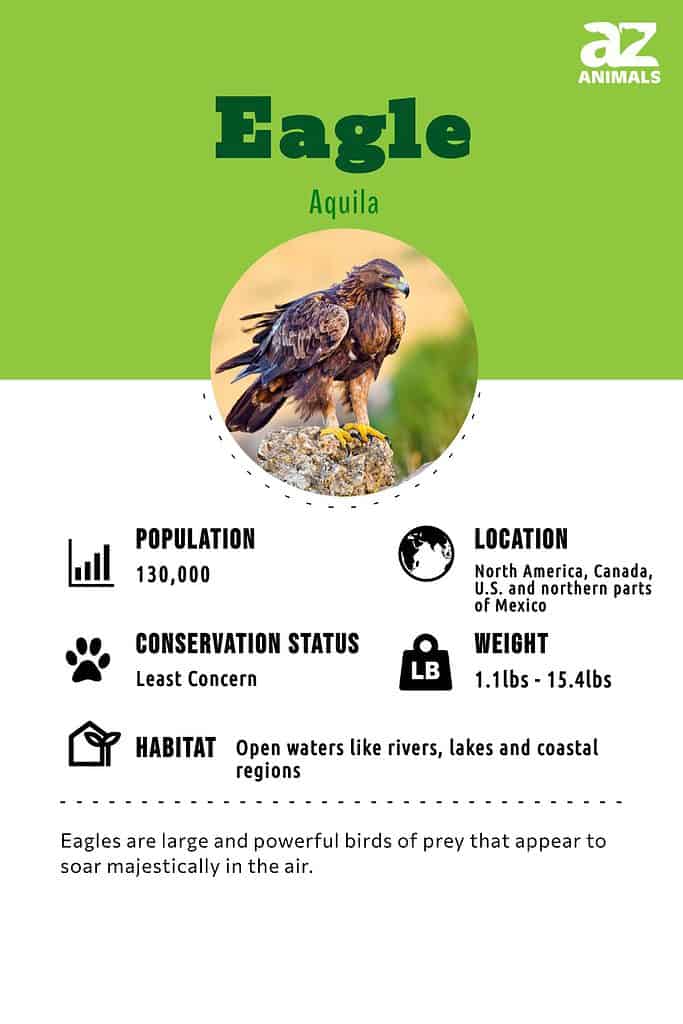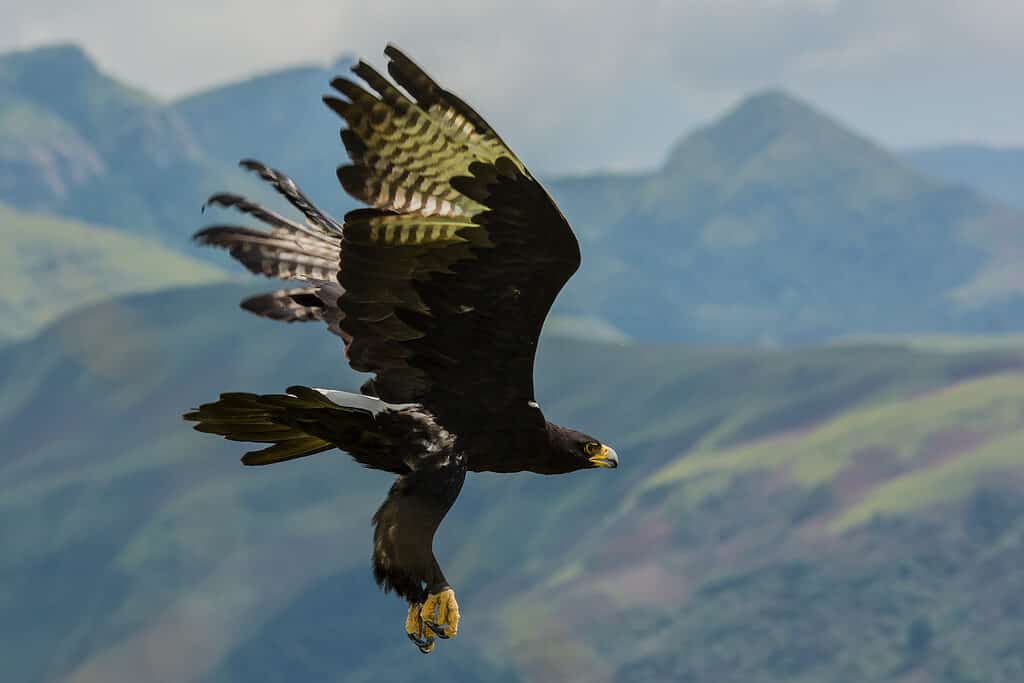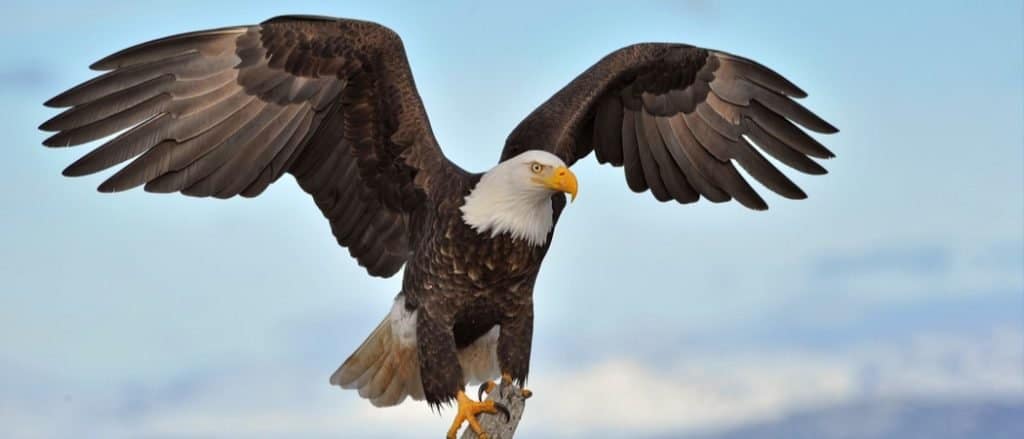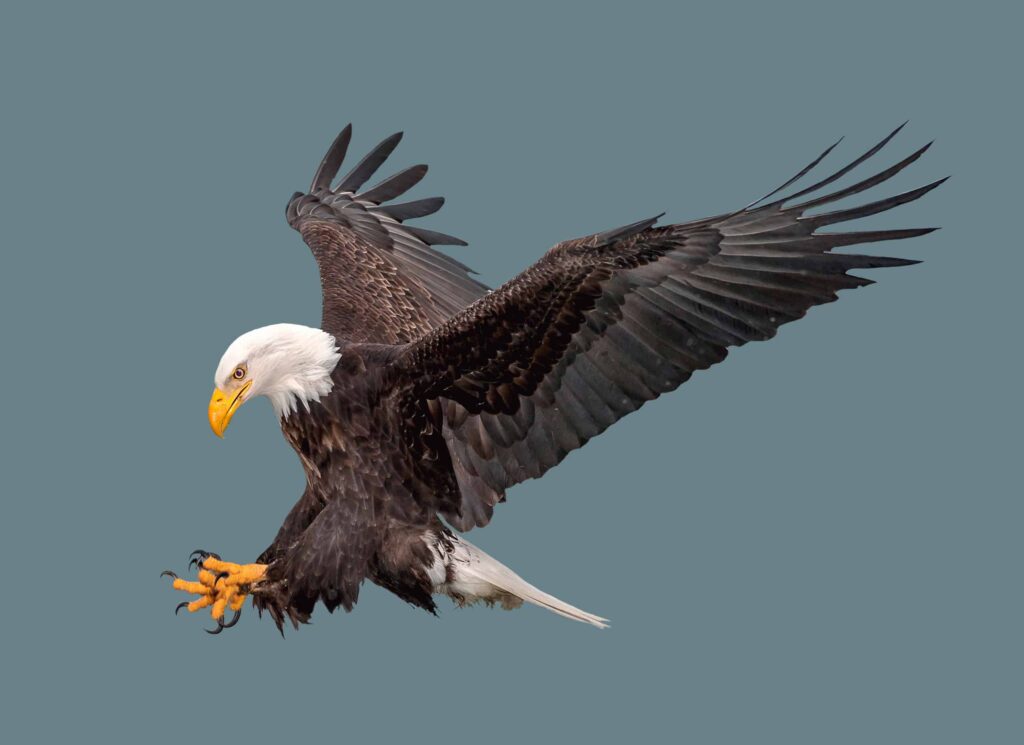Eagle
Has exceptional eyesight!
Advertisement
Eagle Scientific Classification
Read our Complete Guide to Classification of Animals.
Eagle Conservation Status
Eagle Facts
- Lifestyle
- Solitary
- Favorite Food
- Fish
- Type
- Bird
- Average Clutch Size
- 2
- Slogan
- Has exceptional eyesight!
- Nesting Location
- In trees or on cliffs

The sharp-eyed eagle is among the most fearsome predators of the animal kingdom.
Nicknamed the “king of all birds,” eagles are large and powerful birds of prey that appear to soar majestically in the air, searching for their next meal.
Although not the most agile flyer, its remarkable speed in the air certainly belies its enormous size relative to other birds.
Most species are well-protected by governments, conservation organizations, and international acts around the world, but a few of the more obscure species are in danger of extinction.
6 Incredible Eagle Facts!

The grip of the bald eagle is actually 10 times stronger than a human.
©Eleanor Esterhuizen/Shutterstock.com
- The Eagle bird probably first evolved from kites some 36 million years ago.
- The eagle bird has served as a very common symbol of strength and power in many human cultures. They adorned the national emblems of Rome/Byzantium, Russia, and many Germanic states. The unusual-looking double-headed eagle is a common historical motif that may stretch back to the time of ancient Mesopotamia.
- The grip of the bald eagle is actually 10 times stronger than a human.
- Despite their much smaller body weight, the eye of an eagle is about the same size as a human eye.
- Eagles undergo a process called molting in which they gradually lose their feathers one at a time and grow completely new ones about every year. Some species will lose feathers equally on both sides to maintain proper balance.
- The Eagle bird can carry up to four times their own body weight, making it one of the strongest birds in the world. Learn about the strongest animals in the world here.
Scientific Name

There are around 60 different species of eagles
©Al Carrera/Shutterstock.com
An eagle is a group of particularly large birds that belong to the family of Accipitridae (this scientific name is derived from the Latin word accipiter, which means hawk). Many different types of birds belong to this family, including vultures, kites, and hawks. What distinguishes the eagle is its larger size and massive beak.
There are some 60 species of eagles still living in the world today. They can be divided into several main groups: fish or sea eagles, serpent eagles, forest eagles, and booted eagles. These are informal groups and not necessarily taxonomical ones. What many Americans may not know is that the bald eagle (scientific name Haliaeetus leucocephalus) is actually a type of sea eagle.
Evolution and Orgins

Largest Eagles in the World
©FloridaStock/Shutterstock.com
Tens of millions of years ago, there was an ancient groups of birds that were eventually named as Kites. These birds developed like today’s bald eagles. As far as we know, early kites were thought to scavenged and hunt fish. Somewhere around 36 million years ago, the first eagles descended from kites.
Eagles belong to several different groups of birds. Most of the 68 species of eagle are from Eurasia and Africa.
Common Types of Eagles

Bald eagles are large flying birds and fierce predators.
©PHOTOOBJECT/Shutterstock.com
- Bald Eagle Bird – The bald eagle is the national bird of the United States. These birds have white heads and tails with brown bodies and are found near open bodies of water with old-growth trees that they use for nesting.
- Harpy Eagle Bird – Harpy eagles are found in tropical rainforests in Mexico, Central America, and South America. These birds have dark grey feathers with white undersides, a black band across their necks, and grey feathers on their heads.
- Golden Eagle Bird – Golden eagles can be found in Europe, Asia, North America, and parts of Northern Africa. Adult golden eagles are dark brown with slightly paler wing feathers and golden napes.
- Stellar’s Sea Eagle Bird – Stellar’s Sea Eagles live in coastal habitats of northeastern Asia. These birds can be identified by their dark bodies, white shoulders, foreheads, tails, and thighs, and bright yellow bills.
- White-Tailed Eagle Bird – White-tailed eagles breed in Northern Europe and northern Asia and generally live near open bodies of water. They have brown body feathers and pale heads and necks with white tail feathers.
Appearance
The eagle is among the largest of all birds; only some condors and vultures can rival it in sheer size. The largest species of eagles, such as the harpy eagle and Steller’s sea eagle, weigh up to 20 pounds and display a wingspan of around 7 or 8 feet from tip to tip. Females actually tend to be larger than males on average, but it’s not entirely clear why; perhaps it’s to protect the chicks from danger while the male is away.
In addition to their size, the eagles are further distinguished by their sharp, heavy beaks (which end in a downward-sloping point) and four big talons on each foot. They also have small projections on the bottom of their feet called “spicules” to grasp prey.
Unlike the scavenging vulture, eagles also have a fully-feathered head, sometimes capped off in a luxurious-looking crest.

©Wang LiQiang/Shutterstock.com
Eagle vs. Hawk
Eagles and hawks are very similar in their behavior and physical characteristics. Some 15 species are even called hawk eagles due to their mixed intermediary features. But in general, hawks are much smaller in size; their wingspan rarely exceeds more than 5 feet.
Behavior

Eagles have exceptional vision that ranks among the best in the animal kingdom.
©Eduardo Medina/Shutterstock.com
These birds have the exceptional vision that ranks among the best in the animal kingdom. Translated into human terms, it would have 20/5 or even 20/4 eyesight. There are a few reasons for this: the enormous size of the pupils, the density of light-detecting cells in the retina, and the shape of the fovea (a small pit in the back of the eye which is responsible for an animal’s sharp central vision). This confers enormous visual advantages.
First, an eagle can see four to eight times farther than the average human, allowing it to spot small prey from up to two miles away, even while in flight. Second, it can also see in a wider range of colors, including ultraviolet. Finally, it can shift focus quickly to zoom in on prey.
But in order to focus on a specific spot, the eagle usually has to turn its entire head in that direction. Fortunately, the eagle also has 14 vertebrae in its neck compared to only seven for humans, enabling it to have a greater degree of rotation.
When the bird finally spots prey, it usually swoops down and snatches up its unsuspecting victim in its feet and talons. In this action, it acts with remarkable speed. The common golden eagle can dive down at speeds of around 150 to 200 miles per hour, which is nearly equal to the peregrine falcon, the fastest animal in the world.
In flight, the golden eagle can only maintain speeds of around 28 to 32 miles per hour, which still allows it to cover much of its hunting ground quickly in a day. Most of these birds are sedentary (which means they maintain a strict territory all year round), but a few species and subspecies may undertake a partial or full migration for the cold winter months.
When several eagles gather together in groups, it is called a convocation, congregation, or aerie. But these birds are not really one for large social gatherings. Instead, it tends to maintain a very narrow family life with a single mate and their chicks.
It has few other social contacts besides that. Except for the breeding season, many eagles don’t actually make many sounds. The bald eagle is one exception. It emits a harsh call to communicate with each other or warn away intruders.
Habitat
These birds are found all over the world in almost every single type of habitat, from the far northern tundra to tropical rainforests and deserts. Only two species, the bald eagle and golden eagle are common to North America, while nine species are endemic to Central and South America.
The Eastern Hemisphere contains the greatest concentration of them, particularly in Africa. Many of the islands dotted throughout the Indian and Pacific Oceans even have their own distinct species as well.
Diet
These birds are apex predators in every ecosystem where it’s found. This is specifically reflected in its anatomy: the birds have sharp beaks and talons are specifically adapted for ripping and tearing flesh.
It is also not shy about scavenging for food left behind or killed by other animals. In fact, the bald eagle’s tendency to steal the kills of other birds once prompted Benjamin Franklin to say that it was a bird of “bad moral character” (though despite common belief, he did not propose that the turkey should be the national symbol of the United States instead).
These birds are also a feast or famine type of bird since it can sometimes go several weeks in between meals. For a complete list of the food eagles eat, check out our “What Do Eagles Eat” page.
What does the eagle eat?

These birds’ preferred diet depends mostly on where it lives and what it’s adapted for. The most common prey includes fish, crabs, snakes, amphibians, small birds, rodents, and other mammals, sometimes as large as a deer or pig. However, these birds rarely just stick to a single type of food.
Although they may have a single preference (fish eagles obviously consume fish), they will also eat a wide selection of other foods based on what’s available at the time. If the meal is too large to carry in its talons, then the bird will eat it directly where the animal was killed.
Predators and Threats
Up until the 19th and 20th centuries, these birds have historically faced few threats in the wild. But the combined effect of overhunting, habitat loss, and pesticide use (which seeped into the environment and water) threatened many species with extinction. In places where hunting and pesticide use are tightly regulated, eagle numbers are quickly recovering.
What eats the eagle?
An adult has no other natural predators in the wild. But eggs and chicks may be preyed upon by hawks, owls, raccoons, bobcats, and other carnivorous animals.
Eagle Reproduction, Babies, and Lifespan

Baby eagle nesting
©KGrif/Shutterstock.com
Following a brief courtship display, which can include an impressive aerial performance and synchronized behavior, these birds form exceptionally strong bond pairs that mate for life.
This allows them to create and keep building upon the same nest year after year, usually in a high and inaccessible cliff or tree.
These nests, which also go by the name of eyries, are usually composed of sticks, moss, lichens, and other plant material. However, most of these birds only use the nest when they are actually raising their young and abandon it temporarily for the rest of the year.
Once the female lays her eggs, she incubates them for a month or two, while the father hunts and provides most of the food. These birds can produce anywhere between one and four eggs, but the larger, dominant chick may end up killing or out-competing the smaller one.
While this may seem cruel, it is an effective strategy for ensuring that one chick almost always survives, especially since mortality rates are already quite high among the young.
They will usually grow their flight feathers after a few months, but since they have such long maturation periods, it may take up to three or four years before they become adults. The life expectancy of the typical species is around 20 to 30 years in the wild. As it ages, the bird begins to lose some of its hunting edges. In captivity, where it always has a guaranteed meal, these birds can sometimes live around 50 years of age.
Population
Most but not all species around the world appear to be in excellent health. The bald eagle is considered to be the species of least concern by the IUCN Red List with perhaps more than 100,000 individuals remaining. This is a remarkable bounce back from the 1980s and 1990s when it was still on the endangered species list.
The golden eagle is likewise a species of least concern with more than 100,000 individuals left. By contrast, the harpy eagle of Central and South America is near threatened and in decline. The steppe eagle of Central Asia is likewise in decline. Although there are some 50,000 to 75,000 adults remaining, it is listed by the IUCN Red List as an endangered species.
Eagles in the Zoo
The bald eagle bird is one of the most popular exhibits in American zoos. It can be found at the San Diego Zoo, Saint Louis Zoo, Smithsonian’s National Zoo, Lincoln Park Zoo, Detroit Zoo, Oregon Zoo, Louisville Zoo, Minnesota Zoo, Denver Zoo, Tulsa Zoo, Cincinnati Zoo, Houston Zoo, San Francisco Zoo, and so much more. The San Diego Zoo, along with many other zoos, also has a golden eagle, a crowned eagle, Steller’s sea eagle, and a harpy eagle.
Up Next…
View all 117 animals that start with EEagle FAQs (Frequently Asked Questions)
What's the difference between ospreys and eagles?
Eagles are generally larger than ospreys. In addition, ospreys feed almost exclusively on fish while eagles have more variety in their diet. Ospreys are also a single species while there are more than 60 species of eagles.
Are Eagles herbivores, carnivores, or omnivores?
Eagles are carnivores, meaning they eat other animals.
What Kingdom do Eagles belong to?
Eagles belong to the Kingdom Animalia.
What class do Eagles belong to?
Eagles belong to the class Aves.
What phylum to Eagles belong to?
Eagles belong to the phylum Chordata.
What family do Eagles belong to?
Eagles belong to the family Accipitridae.
What order do Eagles belong to?
Eagles belong to the order Falconiformes.
What type of covering do Eagles have?
Eagles are covered in feathers.
In what type of habitat do Eagles live?
Eagles live in open waters like rivers, lakes, and coastal regions.
What is the main prey for Eagles?
Eagles prey on fish, mammals, and reptiles.
What are some predators of Eagles?
Predators of Eagles include humans, hawks, and raccoons.
What are some distinguishing features of Eagles?
Eagles have long, curved beaks and strong, sharp claws.
How many eggs do Eagles lay?
Eagles typically lay 2 eggs.
What is an interesting fact about Eagles?
Eagles have exceptional eyesight!
What is the lifespan of an Eagle?
Eagles can live for 15 to 30 years.
What is the Eagle's wingspan?
The Eagle has a wingspan of 70cm to 250cm (27.5in to 98in).
How fast is an Eagle?
An Eagle can travel at speeds of up to 100 miles per hour.
Could an eagle kill you?
An eagle would almost never try to attack a person except in self-defense. However, the sharp talons and beak could probably do some serious damage.
Is the eagle the strongest bird?
The harpy eagle is generally considered to be the strongest bird in the world. It can carry 100% of its own body weight (up to 20 pounds) in its talons.
Why are eagles so special?
Eagles are among the largest and most powerful birds in the world. Their eyesight is also one of the strongest in the entire animal kingdom. They are also beneficial to the environment by keeping the populations of prey animals in check.
Can an eagle carry a human being?
Since most eagles can only carry a few pounds at a time, they would not be able to carry a person in the air. However, a larger eagle might be able to carry a smaller child.
Where do eagles live?
Eagles live in many different environments all over the world. Almost all species have a preferred habitat, such as wetlands, forests, mountains, or plains.
What do eagles eat?
Eagles tend to consume small animals like rodents, lizards, and fish.
How do Eagles have babies?
Eagles lay eggs.
What's the difference between an eagle and an owl?
Eagles have a larger wingspan than owls, but the difference is not that great. Eagles’ wingspans can reach lengths of 80in or longer in very rare cases like the Martial Eagle with an 8.5-foot wingspan.
Owls also have a very big wingspan, with the largest of their species having wings that grow up to 72 inches in length.
Who has bigger claws between an eagle and a tiger?
Harpy eagles have claws as long as 5 inches, which are bigger than a typical tiger’s claws which grow up to 4 inches in length.
Thank you for reading! Have some feedback for us? Contact the AZ Animals editorial team.
Sources
- Britannica, Available here: https://www.britannica.com/animal/eagle-bird
- Live Science, Available here: https://www.livescience.com/18658-humans-eagle-vision.html
- San Diego Zoo, Available here: https://animals.sandiegozoo.org/animals/bald-eagle
- Nature, Available here: https://www.pbs.org/wnet/nature/american-eagle-bald-eagles-evolutionary-ancestors/4274/

















